A few years ago, a strange idea emerged from the clinical world: the insect head. White coats started telling lifters to lock their heads onto their torsos during hip hinge lifts — deadlifts, swings, cleans, and snatches, both barbell and kettlebell.
I urge you not to get bogged down by the science and the pseudo-science of their arguments. Instead, ask yourself these two questions.
1. Is there an epidemic of neck problems from the traditional technique — the head up and the neck in extension — among powerlifters, weightlifters, and hard style gireviks?
The answer is: No.
Sure, some athletes from any sport have neck issues, but good luck correlating them to neck extension in hinge lifts. Some powerlifters have neck problems — mostly from driving the head hard into the bench on the bench press. Some weightlifters and gireviks tweak their necks — usually by whipping them inappropriately. But from a simple act of keeping their heads up, the way they have been doing it since they were crawling babies? I do not think so.
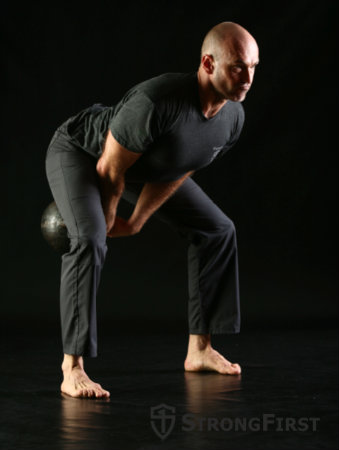 Brett Jones, Master SFG, has pointed out that some folks can have problems when their thoracic extension is limited. The neck has to compensate to keep the eyes on the horizon and goes into hyperextension. Indeed. So what is the answer? Fixing the lack of mobility with professionally applied corrective exercise. Medical intervention, if there are medical issues.
Brett Jones, Master SFG, has pointed out that some folks can have problems when their thoracic extension is limited. The neck has to compensate to keep the eyes on the horizon and goes into hyperextension. Indeed. So what is the answer? Fixing the lack of mobility with professionally applied corrective exercise. Medical intervention, if there are medical issues.
The answer is not dumbing down the classic technique to accommodate dysfunction. That would be akin to our government lowering the PT standards for the military and firefighters when fewer recruits are able to pass the existing standards.
Indeed, there may be a particular medical case when the doctor tells the patient that he or she must keep the neck neutral throughout a hip hinge exercise. If that is your doctor’s order — follow it. But if this is a prescription for another patient, don’t you understand the risks of taking someone else’s drugs? Medical Rx for one patient ought to never be confused with the standard operating procedure for healthy people.
Now to the second question:
2. Has the new technique improved the performance of top lifters?
The answer is: for some. And the technique is far from being new.
Hugh Cassidy and Franco Columbu used it four decades ago. A review of championship deadlift techniques reveals a remarkable variety of head positions. Andy Bolton cracked the mystical 1,000-pound barrier with a neutral neck — he looks at a spot six to ten feet in front of him at the start of the pull. Lamar Gant, the first man to pull five times his bodyweight, 661 at 132 pounds, did it with an extremely hyperextended neck.
Moving your body into one position or another is often a trade-off. Extending the neck helps to activate the posterior chain — while weakening the abs and the quads. A talented powerlifter, with the help of his coach or just through great body awareness, will eventually figure out the optimal amount of trade-off for himself. (Only competitive powerlifters should do this. Recreational lifters and athletes from other sports should follow the Olympic lifting and kettlebell lifting guidelines below.)
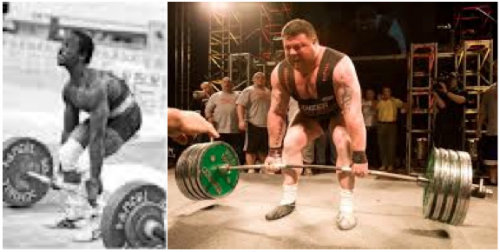
Unlike the slow-moving deadlift, quick “pulls” (barbell or kettlebell) tolerate no variety in neck alignment. There is only one way — head up!
If a champion weightlifter cleans 500 pounds, you know he can easily deadlift a couple of hundred pounds more. That means his quads and abs are not greatly challenged by the first pull (the deadlift part of the clean or snatch). So robbing Peter (the posterior chain) to pay Paul (the quads and the abs) would be wasteful as Peter is the one doing most of the work in quick pulls.
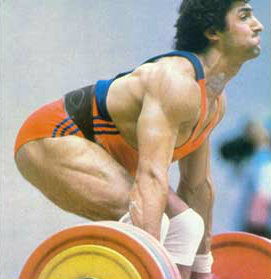
The same applies to a hard style girevik. He has no trouble breaking the kettlebell off the platform and his spine is not crushed by enormous loads. His mission is to accelerate the relatively light kettlebell to 10G and it is the job of his posterior chain. So he needs to maximally reinforce it, and neck extension does exactly that. Lift your head up — extend, not hyperextend — on the bottom of your pull and your entire back side will immediately light up, vibrating with stored energy like a bow.
From Supertraining, a fundamental text on strength:
The position of the head has a powerful effect on overall posture… As it is well known, in gymnastics a dropping of the head forward initiates the forward somersault, just as the backward throwing of the head initiates the back flip in gymnastics and diving… It is vital to use a definitive extension of the neck to facilitate powerful contraction of the postural muscles of the trunk during all lifting movements from the ground. This facilitating action of the head should not be done so as to cause a pronounced hollowing of the back…[but] in such a way as to maintain as closely as possible the neutral spinal disposition, with its three natural curvatures… Correct positioning of the head will ensure that the back assumes the posture where trunk stabilization is shared between the erector muscles and the spinal ligaments… Action of the eyes is closely related to the action of the head, so it is essential to facilitate correct…posture by using the eyes to guide the head into the position which is most appropriate for each stage of the given movement. Generally, the neutral spine position is maintained most easily if the eyes are looking almost directly ahead and fixed on a distant object.
We accept the above as the SFG standard.
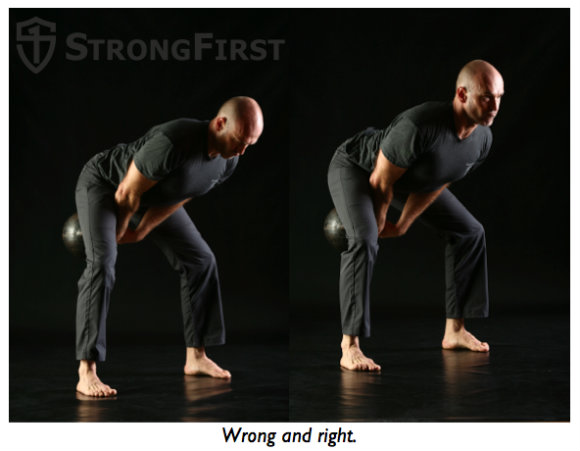 The only person I have ever seen manage a perfect hard style swing, powerful and graceful, while keeping his neck close to neutral is Master SFG Brett Jones. He adds some nuances to the standard recommendation and offers an option for some:
The only person I have ever seen manage a perfect hard style swing, powerful and graceful, while keeping his neck close to neutral is Master SFG Brett Jones. He adds some nuances to the standard recommendation and offers an option for some:
If you are getting yanked into extension during the eccentric catch of the kettlebell, then it is a bad thing. If the arms are connected to the body and you choose to hold the extension, it can be a very good thing. When I try to keep my eyes on the wall in front of me I feel like I am jerked into a bit of cervical extension and it doesn’t feel good. For me it is much better having a focal point closer to me (four to six feet in front of me).
Brett adds that he does have a slight cervical extension, even though he is looking at the floor four to six feet in front of him. He observes that most people who think they are neutral are actually in flexion.
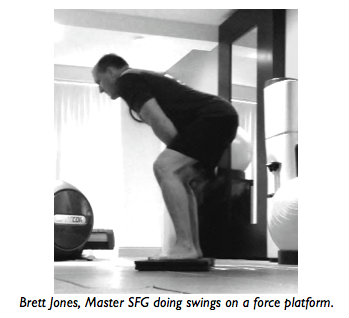 The Master SFG also warns against hyperextension. It is easy to get into if you are doing your swings almost stiff-legged. If your knees are almost straight on the bottom of the swing, your torso is bound to be almost parallel to the ground. That means looking straight ahead will automatically hyperextend your neck. Remember that the hard style swing is related to a jump and as such demands some knee flexion — not to the point of squatting, but enough to activate the glutes.
The Master SFG also warns against hyperextension. It is easy to get into if you are doing your swings almost stiff-legged. If your knees are almost straight on the bottom of the swing, your torso is bound to be almost parallel to the ground. That means looking straight ahead will automatically hyperextend your neck. Remember that the hard style swing is related to a jump and as such demands some knee flexion — not to the point of squatting, but enough to activate the glutes.
In Summary
- The standard recommendation for swings is to keep your eyes on the horizon, which will place your neck into mild extension on the bottom of the swings — provided you have healthy thoracic extension and you are not stiff-legging your swings. In the gym the “horizon” can be where the wall and the floor meet if you stand far from the wall, an electric outlet, etc. Note that the “horizon” is lower than your eye level.
- If your upper back is too immobile to allow you to look straight ahead on the bottom of the swing without hyperextending your neck, see a specialist to correct it before swinging kettlebells.
- If you have the required mobility, are not stiff-legging your swings and your neck is still not comfortable on the bottom of the swing, first make sure it is your lats and not your traps and neck that absorb the force of the kettlebell backswing. If your technique is correct, you are healthy, and your neck is still not comfortable, experiment with a lower focal point on the bottom of the swing — typically five to ten feet in front of you.
- Never whip your neck into extension on the bottom and/or into the protracted “chicken” position on the top of the swing (the “bobble head”).
Heads up and power to your swings, ladies and gentlemen!
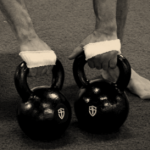
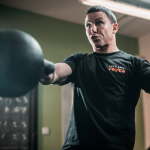
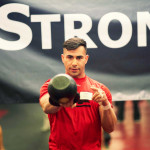
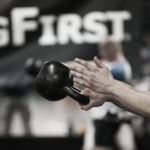

I just came across this logical and elegant article. Early 2014 was a frustrating time as the “white coats” marched out of weekend seminars to their keyboards to preach the perils of “breaking the canister” with traditional kettlebell swing technique. I wrote a similar post at that time in response to the push-back that my coaches were getting from novice lifters who were taking that cautionary advice as gospel. My post throws a few jabs at the opposition and gets into a few elements of the benefits of mild cervical extension at the bottom of the swing.
http://sportsmednw.com/neck-injuries-with-kettlebells-fix-your-gaze-fix-your-swing/
So happy to see this issue addressed by you personally Pavel. I feel the “Corrective experts” seem to push this packed neck thing which takes a tremendous amount of strength and power away from the athlete IMO. I call it the “Drinking Bird” swing when talking KB swings. They actually look as though they are losing their lat activation when swinging with a truly packed neck, but that is simply my observations. Stay Strong.
Todd
Great article.
With a herniated neck, for me close to neutral was and still very important, but that was a very specific situation, and needed specific solution. But if we see two natural athletic movement – vertical and horizontal jump – they both require some neck extensions.
I tried neutral position doing the swing and it feels very awkward… Thanks for the clarifications, it makes perfect sense!
Great article!! One of our principles of Shurite Kempo, is gaze, feet, hands. The body goes where the eyes lead. This principle is applied to our kata, like the TGU look at the bell for safety, the bell goes where the eyes go.
your the best pavel
Regarding Yurik Vandanyan’s records… It’s a good thing steroid use was not an issue in the Soviet Block in 1980:-)
Frank, it is a good thing all lifters are suddenly clean now.
Zing!
Great article,
Thank you Pavel. It reminds everybody once again that the body works as a unit and if some parts of it could be working better, well our job is to fix them in order for the movement itself to be more efficient..
Heads up!
Daniele
Thank you, Daniele!
Oh, and one more thing. With a herniated C6/C7 I had to modify my head position a bit, from more to less extension, but never to completely neutral.
Chris – stick drill was always only one drill out of many.
Most people can’t hinge the hip while keeping the spine motionless, plus 3 point touch emphasize the pelvis travel back. Stick drill is only a walking stick here, when hip hinge created – we don’t need it anymore. Pushing the hip back to the wall can be next step, since this is still unloaded pattern, but emphasize the pelvis move back.
I have found that keeping the neck in extension relults in “shorting” the swing in many cases- poor hinge at the hip, a lot of flipping of the KB at the “back” of the swing. I coach “eyes down” but in reality it is not directly down but rather 65-7 feet in front on the floor. It takes a lot of discipline to keep the neck in extension and have proper swing mechanics for many clients. Thank you for the article and information!
Important article Pavel. Even the baby at 3 months in prone sphinx or 8-9 months quadruped extends his/her neck putting a wrinkle in the back of the neck. This is driven by function. If the goal is to move forward the infant must see what’s in front not just what’s underneath. The functional approach usually leads us down the correct path. An overdue reminder Pavel.
Thanks
Craig
Thank you, Craig!
I watched Chris’ deadlift video; very impressive! Looks just like a kettlebell swing.
Craig, who thinks of those who ascribe to the symmetric tonic neck reflex inhibiting hip extensors, while overstimulate spine extensors ??
You think of the rule strength of the spine that says this is as tough as: (number of mobile curvatures in neutral x number of mobile curvatures in neutral) +1 .. ??
Great article as always Pavel. Learning to properly hinge your hips (I love Dan John’s Hip Assessment Tool video: http://youtu.be/34saz57cxjs), mobilizing your thoracic spine (http://youtu.be/LC3AFMXYYyw?list=UULSV-sAkPLX_lJP0N1gNVzg), and keeping your neck in the neutral or slightly extended position by focusing gaze on the horizon are all great pointers. Excessive cervical and lumbar extension are a great way to end up in my (or a colleague’s) office. This is the last thing I want to happen – these exercises are supposed to keep you out of my office for injury care!
Thank you, Steve!
Head position is relatively unimportant. The head/neck/eyes/middle ear all work together to help coordinate balance and extensor tone. ANY position can be ‘wrong’ if it is clenched or braced in a way that cuts out the responsiveness of the poising mechanisms. Trying to ‘keep the neck relaxed’ doesn’t work either.
In my teaching experience, students need to get over these persnickety imposed attitudes and let things work reflexively. I found myself constantly reminding people to avoid closing their eyes, glazing over, or fixedly staring. I would usually cue them with ‘eyes bright,’ as a reminder to stay engaged. With the eyes really seeing, the head and neck tend to stay alert and responsive. With that overall quality of activity, specific positions can be experimented with. THEN, the possible benefits of ‘position’ advice can be gained. Otherwize fiddling with head position can be just one more distraction.
John, the head position will remain important until we see Olympic lifting records set with all sorts of head positions. And my prediction is that we will not.
Pavel, have you seen this??? Neutral working pretty well…
https://m.youtube.com/watch?v=8MgotTQagxo
But, staring at the ground to ‘keep neutral’ or gross hyperextension to avoid rounding the upper back aren’t the solutions people think they are. Obviously there are specific technical reasons to ‘position’ in specific ways.
But a LOT of advice seems to involved misplaced attempts to control directly, physiological responses that aren’t under direct voluntary control. There were people advocating a ‘neck lock position’ based on a misunderstanding of Alexander’s ‘directions’ which were only about preventing stiffening/collapse.
Alexanders directions? Also the video was designed to prove other dad positions have been used to great success nothing more.
So does this mean that “stick drills” are no longer recommended as a teaching tool?
Thanks for great information,
Chris
Chris, the stick drill remains a valuable tool for immobilizing the spine and learning to move from the hips. Eventually the stick is removed and a slight neck extension is introduced.